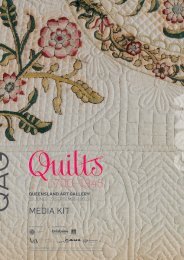Queensland Art Gallery - Queensland Government
Queensland Art Gallery - Queensland Government
Queensland Art Gallery - Queensland Government
Create successful ePaper yourself
Turn your PDF publications into a flip-book with our unique Google optimized e-Paper software.
Collaborative works register art’s grounding in interactions between people, with all the<br />
negotiations and decisions that this entails. They might make us aware of artistic divisions<br />
of labour, in which particular skills or activities are delegated amongst individuals; or of the<br />
constructed nature of a form or style that is, by definition, not the outcome of a single ‘hand’.<br />
In the case of temporary projects, such as Tsai’s and the Aquilizans’, the primary focus is not<br />
the final art work, but rather the act of making, with the <strong>Gallery</strong> itself becoming the studio.<br />
This latter form of practice — often loosely described as relational or participatory art — has<br />
become increasingly prevalent since the 1990s, and has been a strong presence in past APTs.<br />
These include works such as Surasi Kusolwong’s Ruen pae (During the moments of the day)<br />
1999–2000, featuring a structure based on a Thai floating house in which the audience was<br />
invited to rest and contemplate, and Lee Mingwei’s Writing the unspoken 1999, a series of three<br />
sculptural booths in which visitors could write personal letters.<br />
The number of collaborative works in APT6 is a reflection of its importance to contemporary<br />
art-making, not only in the Asia Pacific region, but internationally. Collaboration did not begin as<br />
a prescribed theme for the exhibition, but is rather an element that appeared again and again<br />
when looking at how artists are working today. Wit Pimkanchanapong, for example, often works<br />
across the disciplines of art, design and architecture, and regularly collaborates with Jiro Endo,<br />
Pitupong Chaowakul, and others as Soi Project. The work Fruits 2007–09, featured in APT6, is an<br />
interactive project that invites the audience to construct paper fruit out of preprinted templates.<br />
The task of folding the paper and joining the tabs is likened by Pimkanchanapong to the<br />
process of communication, with the paper models contributing to a fruit stall-style installation<br />
or kept for the contribution of a donation equalling the real fruit’s market price. Soi Project<br />
enables Pimkanchanapong to develop the kinds of experimental, cross-disciplinary works that<br />
he would not be able to realise alone; the word soi (‘small street’ in Thai) evokes connections<br />
made between people in an urban environment.<br />
For Jiten Thukral and Sumir Tagra, the decision to work collaboratively came out of shared<br />
interests and backgrounds, and developed organically as their process of emailing concepts<br />
back and forth during art school began to coalesce as concrete projects. 5 Under the moniker<br />
Thukral and Tagra, as well as the label Bosedk Designs, they have been working across the<br />
areas of art and design since 2000. Their works are developed digitally before being realised as<br />
paintings, sculptures and installations, enabling a fluid and responsive circulation of images and<br />
ideas. Their approach reflects a more recent form of collective work, which, rather than rejecting<br />
the promotion of artistic identity, heartily embraces it, creating their own ‘brand’. The power of the<br />
market to absorb even some of the most resistant activities, and the shifts in identity formation<br />
that technology has brought, has led to collaborative strategies that work with, rather than<br />
against, consumer and media culture. Recent artist groups, according to critic Pamela M Lee:<br />
. . . are as likely to shadow the logic of the corporation as that of the co-op, as predisposed<br />
to emulate the thinktank as the factory floor . . . the appearance of these new collectives . . .<br />
announces a marked shift from the ways collectives have been historically imagined relative<br />
to their ideological filiations. 6<br />
Yoshitomo Nara and graf’s collaborations are also presented under a ‘brand’ name, YNG, and<br />
have been produced in gallery spaces all over the world. Sometimes working with local people<br />
to construct them, each installation features Nara’s works within a structure, or ‘hut’, created by<br />
graf, which reflects the architecture of its location, be it Yogyakarta, Seoul, Malaga or Brisbane.<br />
The ‘huts’ erect a kind of barrier between the works and the museum’s white walls, enabling Nara<br />
Wit Pimkanchanapong<br />
Thailand b.1976<br />
Fruits 2007<br />
Installation view, Sharjah Biennale 2007 / Image courtesy:<br />
The artist<br />
Thukral and Tagra<br />
Jiten Thukral<br />
India b.1976<br />
Sumir Tagra<br />
India b.1979<br />
Effugio (escape) 2008<br />
Installation view, Mori <strong>Art</strong> Museum, Tokyo / Image<br />
courtesy: The artists and <strong>Gallery</strong> Nature Morte, New Delhi<br />
62 63
















